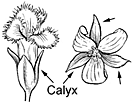ʻŌlapa
Cheirodendron trigynum
Ivy/Pennywort/Devil's Club family (Araliaceae)
Native species ()
ʻŌlapa, an aromatic medium-sized tree common in wet forests through the Hawaiian Islands. It is characterized by paired large leaves with 3–5 finely elliptical or constantly moving on their long slender stalks. The crushed foliage and bark have a strong odor like that of carrot or oil and a spicy or turpentine taste.

©2010 Forest And Kim Starr
Leaves 4–8 inches (10–20 ) long, or with very slender green, purplish or brownish leaf-stalks of 2–4 inches (5–10 ), slightly flattened, enlarged and slightly clasping at base. 3–5 (7), spreading on slender slightly flattened stalks of 3⁄8–1 1⁄2 inches (1–4 ) long. Blades elliptical or 2–5 inches (5–13 ) long and 1 1⁄4–2 1⁄4 inches (3–6 ) wide: rounded or blunt with narrow curved point at straight to blunt at base, edges mostly with small curved teeth or sometimes none, thin or slightly thickened, upper surface shiny green with fine side veins, lower surface dull light green.
Flower clusters () 3–6 inches (7.5–15 ) long, with many slender forking greenish or purplish branches and many flowers spreading on, equal stalks (). Flowers 3⁄16 inch (5 ) long and wide, greenish, composed of cuplike base () 1⁄8 inch (3 ) long, of five tiny teeth, five narrow spreading petals 1⁄8 inch (3 ) long, five short and with inferior commonly 3–4-celled and 3–4 dot-like stigmas.
(berries) are round, about 1⁄4 inch (6 ) in diameter, blackish, with a ring of and stigmas at purplish flesh juice or slightly bitter. Seeds (nutlets) 3–4, more than 1⁄8 inch (3 ) long, brown.
The wood is pale yellow without distinct heartwood, moderately heavy, and moderately hard. It burns when green.
A bluish dye for coloring tapa, or bark cloth, was obtained from the leaves, and bark. eaten by native birds such as the rare ‘ō‘o, ‘ō‘u, and ‘ōma‘o. The wood was used for bird hunting spears. Distinctive leis can be made by binding or tying together the leaves.
The Hawaiian term for graceful dancers is also ‘olapa. Performers of the native hula dance were divided into two groups, the ‘ōlapa and ho‘opa‘a. The ‘ōlapa were the dancers, perhaps because their movements were like the fluttering movement of the tree leaves. The ho‘opa‘a stayed in one place, chanting and playing musical instruments.
Common and widespread through the Hawaiian Islands, mostly in wet forests at 2000–7000 ft (610–2134 ) altitude. It is the most prevalent understory tree in the forest on Hawaii in the zone within 1000–4500 ft (305–1372 ), where koa and ‘ohi’a commonly intermix.
Special areas
Haleakala, Volcanoes, Kipuka Puaulu
Champion
Height 37 ft (11.3 ), c.b.h. 4.5 ft (1.4 ), spread 28 ft (8.5 ). Hawaii Volcanoes National Park, Hawaii (1968).
Range
Hawaiian Islands only
Other common names
’olapalapa, mahu, kauila mahu
Botanical
Cheirodendron gaudichaudii (DC.) Seem.
Many varieties of this species have been named but currently are not accepted. The generic name Cheirodendron, from Greek hand and tree, refers to the or leaves with five like fingers in a hand.











